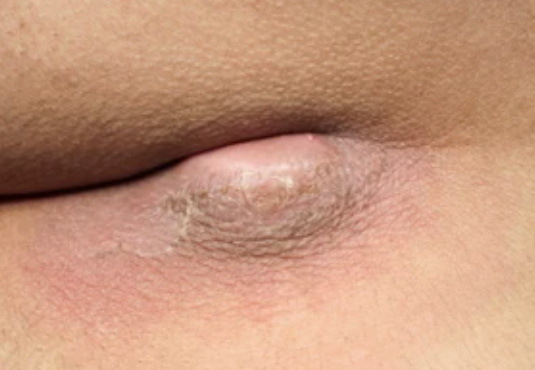
Pilonidal sinus, commonly known as "hair nest," can occur in both genders but is more frequently seen in men. While it most commonly appears in the sacral area, it can also be found in other parts of the body such as the scalp, armpits, and neck.
Pilonidal sinus is a condition that occurs when fallen hairs enter the skin through pores, forming a cystic structure that results in the accumulation of hair inside.
A pilonidal sinus abscess develops after a pilonidal sinus cyst forms and the cyst cavity enlarges due to the accumulation and proliferation of hairs. Since the sacral area is the most common site, one or more openings associated with the pilonidal sinus cavities may occur. Fluid begins to drain from these openings. If the cyst becomes contaminated due to skin sources or other reasons (such as infection),a painful, reddened, swollen lesion known as a pilonidal sinus abscess can emerge.
If left untreated, a pilonidal sinus abscess can grow and spread to larger areas, damaging surrounding tissues and complicating treatment. If the patient has any issues with their immune system, it can lead to more serious clinical conditions.
If not treated (such as by drainage and evacuation of the abscess),a pilonidal sinus abscess can lead to significant pain that severely impacts the patient's social life and daily activities, as well as fever. Therefore, it is essential to drain the pilonidal sinus abscess, clean the cavity, and start antibiotic treatment. Antibiotic treatment without draining the abscess will not aid in the patient’s recovery.
The drainage of a pilonidal sinus abscess is usually done in a clinic setting under local anesthesia by making a small incision over the abscess, allowing it to be drained, and then washing the cavity (loge) to clean it. Antibiotic treatment is then initiated.
If the patient does not agree to the procedure under local anesthesia, the drainage can be performed in an operating room under general anesthesia. The procedure takes about 15-20 minutes, and the patient can walk out afterward and return to their normal activities.
Pilonidal sinus abscess can cause significant pain that prevents the patient from sitting comfortably and disrupts their overall quality of life. Anesthesia for draining the abscess can be administered either as local or general anesthesia.
The costs of draining a pilonidal sinus abscess vary depending on the location of the abscess. For price information, please contact us.
After treating a pilonidal sinus abscess (once the abscess has been drained),there is a high likelihood of recurrence unless a permanent surgical procedure is performed regarding the pilonidal sinus.
We are committed to being with you during your treatment process for general surgery diseases with accurate diagnosis and effective treatment methods. Here, you can read the real experiences of my patients who share their health journey with me. Their sincere comments can be a guide for you as well.
I reached my teacher Sezai through a reference. As a result of my research on the internet, I decided to meet with my teacher. We first talked on the phone. He listened to my complaints very attentively and carefully, and I was diagnosed with keloid as a result of the pie{...}
First of all, I would like to say that I am very happy to have met Dr. Sezai and for saving me from this disease. I learned that I had breast cancer during my routine check-up. While I didn't know what to do in the face of this situation that destroyed me and my family, I{...}
The reason I met my teacher Sezai was related to the problem I had with my gallbladder. One evening, I went to the doctor at work complaining of stomach pain. After the examination, gallbladder surgery was recommended to me. I learned from one of his clients that Sezai B{...}